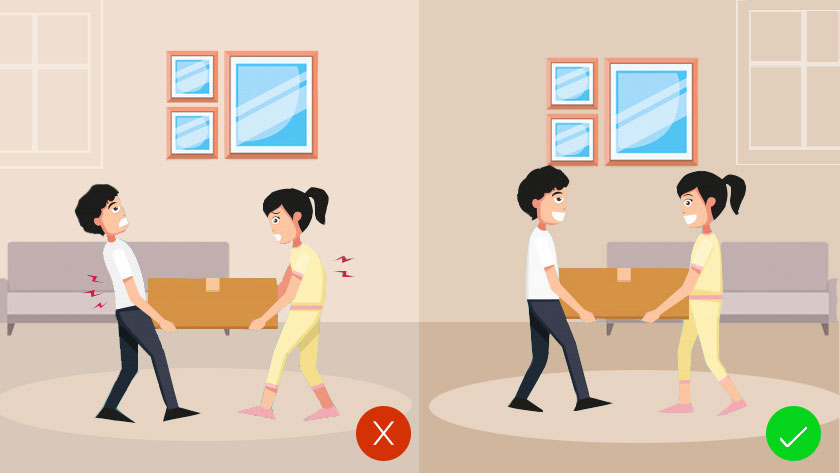How To Lift Heavy Boxes Correctly: The Complete Guide

Every step of your move comes down to testing your physical strength.
Although packing does not require too much physical exertion, your body will be fully put to the test when you have to lift and move the packed boxes.
If you’ve been smart and hired a moving company, you have nothing to worry about. However, if you’re planning a DIY move, it’s vital for you to learn the proper lifting techniques so that you don’t hurt yourself, or damage the goods or house property.
By lifting heavy objects in the wrong way, you can easily catch a muscle pull, strain your back and neck, or end up with sore legs halfway through the move, preventing you from continuing your work; it could become worse if it ends up causing lifetime injuries.
Worry not! Read on to learn the complete step by step procedure about how to prepare before getting ready to lift boxes, and the proper lifting techniques you should follow to keep your body safe and be injury-free.
Note: If you have a history of back or spinal cord problems or any other such health issues, it’s advisable to take help from someone you know or hire professionals to do the entire job without stressing yourself out.
How to Prepare Before Lifting Heavy Boxes
Your main aim of moving day should not be to finish the work quickly or speed up the process but to ensure that you are safe from any injuries. Remember the rule of thumb: Preparation is the key to success!
Here’s how you should prepare yourself before you begin lifting the boxes:
Buy Sturdy Boxes
The essential requirement to ensure safe lifting of boxes is that the box itself is strong and capable of holding the weight of the objects placed inside it. When the box is made of good quality and durable material, lifting becomes more relaxed since you get a good grip on the box without being constantly anxious about the box falling open as soon as you lift it off the ground.
Therefore, check the quality of the box you’re using before packing and sealing it. If the box is flimsy or not as strong, pack only light-weight items, so that it’s easier to lift and move them.
Ask Family/Friends for Help
You should avoid lifting heavy objects by yourself if you have a history of back problems or if you are not able to manage the weight by yourself. Ask your close ones for a helping hand if you’re unable to do the heavy-lifting alone.
If you’re not able to find assistance from friends or family members, strongly consider hiring professional relocation experts to avoid hurting yourself during the move.
Wear Appropriate Clothing
Moving day invites many injuries: scratches, hurting your legs/hands, or pulling a muscle in your back/neck. The simplest solution to avoid all this is to dress appropriately from top to bottom.
Clothing: Stick to comfortable clothing like yoga pants and loose t-shirts. Choose cotton material which is stretchable and absorbs sweat, rather than synthetic or nylon which feels suffocating. Avoid jeans or any other tight pants which make it difficult to bend your knees (because you’ll be bending a lot while moving boxes).
Shoes: Wear closed-toe sneakers or sport shoes, which protect your feet and heels from internal as well as external injuries since they have proper cushioning and grip on the bottom, and are fully covered. Avoid open-toed shoes, heels, or sandals since your feet would be more prone to injuries.
Keep the Pathway Clear
Coming across obstacles while carrying heavy boxes is not only challenging but also dangerous to you as well as everyone involved in the move.
Clear the entire path from the house to the truck to allow for smooth movement of goods. Doing so will help carry the items to and fro easily, and ensures complete safety of goods as well as yourself.
Proper Lifting Techniques
Distribute the Weight Evenly
Distribute the weight of the items placed inside the box evenly, so that the box does not become heavy on one side and light on the other; that will only make it impossible to lift and carry them.
Place the heavier items on the bottom, so that the lighter objects don’t get crushed under their weight. Also, arrange the things in such a way that the weight is distributed throughout the box.
Stand in the Right Position
It’s essential to maintain the right posture before lifting anything. The right position to stand while lifting bulky goods is:
- Stand straight facing the box;
- Don’t stand too close nor too far from the box;
- Keep your feet at shoulder-width apart;
- Keep your back straight;
- Place one foot slightly in front of the other;
Keeping this posture will make sure the weight of the box you’re about to lift is distributed across your entire body without putting much strain on a particular area, thereby, saving your back and other muscles from any injury.
Test the Weight of the Box
Before actually lifting the box, it’s essential first to check if you can pick it up without a problem since the weight can’t be determined by the number or type of objects placed inside.
Bend down and lift a part of the box from one corner to get a sense of the total weight. Evaluate if you can handle the weight by yourself. If you’re not able to lift even a part of the box, you can either ask your friends for help or transfer some of the weight to other boxes (next step).
If you can lift the box by yourself, jump to Step 5.
Remove objects if the box is too heavy
If the box is too heavy to lift on your own, and your friends aren’t available at the given time, reduce the weight so that you will be able to move them without a problem.
The main point to remember while doing this is: don’t disrupt the balance of weight in the box. In simple words, if you remove any heavy item from the box, replace it with other lighter objects so that it takes up the space emptied by the previous item.
You can carry the heavy items separately down to the truck, or you can also try to distribute the heavy objects such that they can be placed one in each box. That way, you will reduce the number of trips of carrying heavy goods from house to truck.
While Lifting: Bend your Knees, not your Back
The right way to lift a heavy box is by bending at the knees rather than hunching over. By doing so, you can use the leg muscles to lift the box and also prevent the back muscles from getting strained or pulled.
This simple but vital point can’t be stressed enough, because people are habituated to hunching their back before lifting anything; and this is the main reason for back injuries, especially while moving homes.
Keep a good grip on the box
Before you begin to lift the box, make sure you have a firm hold on it. Preferably, hold the box on two opposite corners and grip it tightly with both hands.
You can also use work gloves of good quality which will improve your hold on the box and also safeguard your hands and fingers against injuries.
Lift with your Legs; Hold it Close
As your knees are already bent, use the strength of your legs to lift the box so that you avoid putting too much strain or pull the weaker back muscles.
While lifting the box, keep it close to your inner body (core) so that you have more control on the box. Keeping the box close to your waist also helps maintain stability since the box is closer to your center of gravity.
Walk Slowly; Avoid Sudden Movements
While walking to the truck, take one step at a time without bending/twisting your back or any other part of your body. Avoid sudden/abrupt movements while carrying the load since it may place an enormous amount of pressure on a particular part and cause injury.
Instead of turning your body at the waist, move both your feet together and turn along with the load. Always make smooth and slow movements so that the muscles have time to adapt to the changes in every move you make. Also, make sure your footing is firmly and securely placed while walking to the truck.
While Putting the Box Down: Bend your Knees
Remember to bend your knees and squat down before keeping the box on the ground or in the truck; this will support your entire body and give you better balance. Avoid hunching over and injuring your back muscles. Release the box only when it is placed on the ground firmly, instead of letting go before it touches the surface.
Alternatives to lifting heavy goods
You can avoid injuries altogether by using 2 simple methods which do not involve physically lifting the boxes by yourself. Here’s how you can do it:
Use Moving Equipment
Fortunately, you can make use of special equipment which can be rented from hardware stores or relocation service providers on the day of your move. This way, you will be able to save yourself from a lot of physical as well as mental stress.
There are many types of equipment built to move various goods such as furniture dollies, hand truck, appliance dollies, and many others. You can also rent out moving blankets, padding, and so on, to protect your house as well as the goods from any damages.
Moving Tip:
Making use of moving equipment definitely reduces the chances of injuring yourself, but not by that much, since you still have to physically move the equipment from house to truck or vice versa. It’s important to remember that while using such equipment, it’s always safer to PUSH forward rather than PULL backward.
This way, you’ll need lesser force to move the items, and there will be no muscle wear and tear due to pulling.
Take the Help of Professionals
The safest method, by far, to move your large and bulky goods is by taking the help of professional packers and movers in India. They have years of experience in relocation, and they come armed with the necessary packing and moving supplies that are needed for a safe and smooth move.
When the movers are loading and unloading your goods, you can relax and be stress-free as you don’t need to do a single thing. Your only task during the entire process will be to guide the movers through the corners of your house and direct them to place the goods in the desired spot.
Hiring tip:
It’s challenging to hire packers and movers, except when you go through reliable sources like AssureShift, where you will get a list of pre-verified and genuine moving companies.
Once you share your shifting requirements, we will refer 3 relevant and top packers and movers near you who provide your required services. Our relocation experts will contact you immediately and offer their estimated shifting charges.
You can quickly compare their charges, company profiles, list of services, as well as reviews and ratings, all in a single place. You can hire the best-suited movers according to your requirements and budget within minutes.
Getting to the Bottom
The main lifting techniques for lifting and moving a box is all in the legs! This point can’t be stressed enough, so remember to always bend your knees instead of your back so that you lift safely and avoid any kind of injuries.











